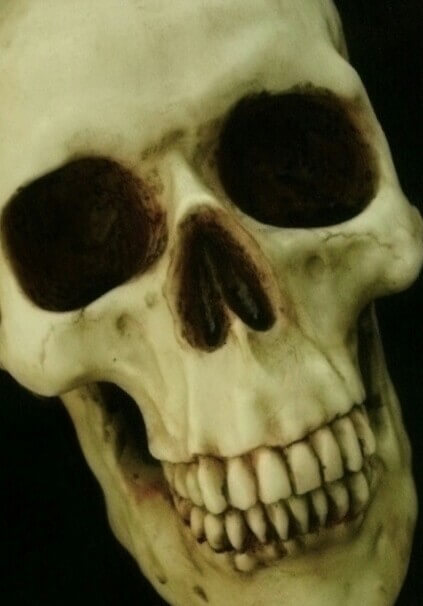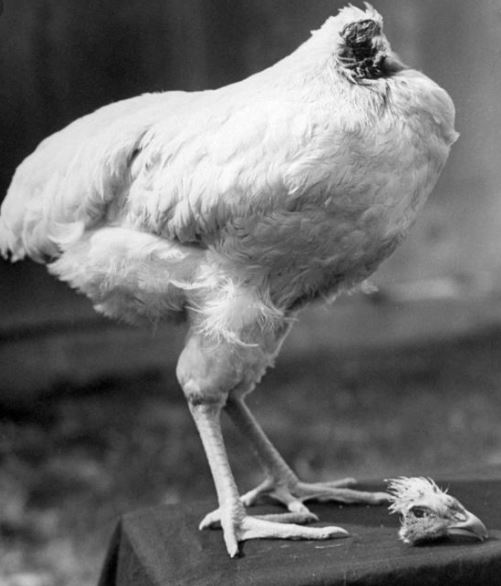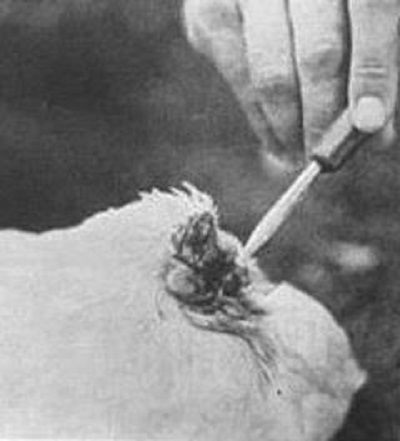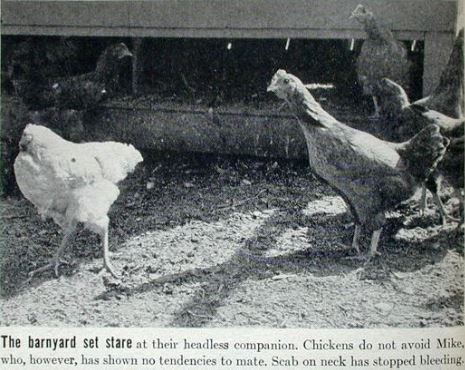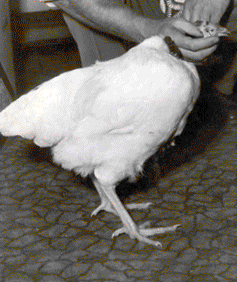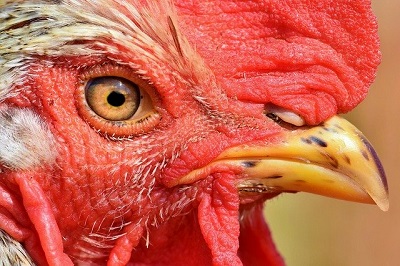This is an article on the story of Mike the Headless Chicken (also known as Miracle Mike). It is an unbelievable, but true story about a chicken that lived for nearly two years without its head. Of course, being very difficult to believe, it was once thought to be nothing but a funny hoax.
However, Mike’s owner took him to the University of Utah in Salt Lake City to prove it was a fact. Despite having a very unusual type of abnormality, Mike was resilient and lived for 18 months after being decapitated.
This post was updated by Trina McMillin.
The amazing story
Miracle Mike (April 1945 – March 1947) was a male Wyandotte chicken. On Sept. 10, 1945, the Olsen home in Fruita, Colorado, was about to experience the unexpected. As Clara Olsen began to plan the evening meal, which would feature a plump, tender chicken, she directed her husband, Lloyd Olsen, to head outside and behead the chosen fryer for dinner. After beheading the fryer, Lloyd would prepare it for cooking: These preparations included de-feathering, gutting and removing the feet. This task was nothing new for Lloyd; however, he would soon see that today would be different — very different from the many days before it.
Lloyd aims to gain favor with his mother-in-law
Lloyd located his bird of choice, an unsuspecting young rooster that was walking around pecking the dry ground beneath it, he began thinking about his mother-in-law. She would be joining them for dinner and Lloyd knew how much she loved the neck. Once he caught the rooster, to appease his mother-in-law, Lloyd tried to estimate the perfect place to cut. He carefully positioned his ax in such a way as to ensure his mother-in-law would enjoy a generous portion of neck bone. After the rooster received the blow from the ax, it ran, staggering around just like the majority of freshly beheaded poultry do; hence the frequently used phrase, “running around like a chicken with my head cut off.”
However, the axe had just missed the chicken’s jugular vein. The failed attempt had left an ear and the majority of the brain stem intact.
How Mike responded to the loss of his head
After its initial shock and staggering run, the bird seemed to shake off the traumatic loss of his head. He returned to preening his feathers and ‘pecking’ for food – needless to say, without a beak to peck with. The Olsen family would not be having this chicken for dinner, at least not that night.
The next morning Lloyd was sure he would find the beheaded rooster lying dead somewhere in the yard; however, when he found the bird sleeping as if he had his head tucked under his wing, it became clear this bird was not dying any time soon. If this rooster had that much of a will to live, Lloyd decided he would take care of him by finding a way to feed and water him. At some point, this miracle rooster was given the name ‘Mike.’
Miraculously, Mike was not only alive, but was even able to balance on a perch and walk clumsily. Although he had limited success, he even attempted to preen, peck for food and crow.
How did Mike eat?
You may be wondering how Miracle Mike was actually fed without his head. This resilient chicken was fed a mixture of milk and water via an eyedropper. Mike was also given small grains of corn.
The University of Utah: Initial Skepticism Leads to Theories
The scientists at the University of Utah were skeptical about this headless wonder, but they were also eager to determine how Mike could survive without a head. According to these scientists, the blade of the ax missed his jugular vein. A clot formed that prevented excessive bleeding, which is what kept Mike from bleeding out. While most of Mike’s head was placed in a jar, the majority of his brain stem and one of his ears remained on his body. The scientists believe that the reason Mike was able to remain healthy directly relates to the reflex actions being controlled by the brain stem.
Now, Mike had a new name, Miracle Mike. He took on a manager and headed out on a national tour, the Olsens followed. Mike was valued at $10,000, which was a substantial amount of money in 1945. To give you an idea as to how much money that was at the time, $10,000 in 1945 is equal to $136,177.78 in 2017. Due to his worth, the Olsens had Mike insured for $10,000.
During the nearly two years that Mike lived without his head, he gained a substantial amount of weight. Initially, he was only 2.5 pounds and prior to his death in 1947, Mike weighed 8 pounds. During an interview, Lloyd stated that, except for his missing head, Mike was a fine chicken specimen.
Mike’s popularity and success in sideshows
It didn’t take very long for the story of Mike’s miraculous survival to get out. Neighbors started to find out about him, and were excited to get a glimpse. Then, a interested promoter had also heard about him. He eventually convinced Mike’s owner into bringing him to the sideshow business to make some money. This gave Mr. Olsen the idea to make some cash to pay the farm off and purchase new equipment. Of course, Mike’s fame encouraged him to take very good care of him.
After his fame had been well-established, Mike began his short, but very successful career of touring sideshows around the country. He was in the company of other freak creatures with rare abnormalities (such as a two-headed calf). If the public wanted to see him in person, they would have to pay a fee of twenty five cents for admission. Amazingly, Mike was able to pull in US$4,500 per month ($47,500 today) for his owner.
Mike’s fame and fortune led to his recognition in Time and Life Magazines. He is also in the Guinness Book of World Records. Now, every year, a Mike the Headless Chicken Festival celebrates Mike’s spirit. This festival is held in his hometown of Fruita, Colorado, during the first week of June.
His final day
In March of 1947, it was finally time to say goodbye to Mike the Headless Chicken. While staying at a motel in Phoenix on a stopover while traveling back from tour, Mike suddenly started to choke in the middle of the night. Due to the fact that the Olsen family had accidentally left their feeding and cleaning syringes at the sideshow the previous day, unfortunately, they could not save his life.
Mr. Olsen claimed that he sold the bird off. This resulted in stories of Mike still out touring in sideshows as late as 1949. However, other sources say Mike’s severed trachea could not properly take in enough air to be able to breathe, which resulted in him choking to death in the motel.
Another image of Mike
How can a chicken survive without a head?
Of course, anyone would wonder how a creature could live even with most of its head severed. It was later determined that Mr. Olsen’s axe had missed Mike’s jugular vein. A clot prevented him from bleeding to death. How did he function? Mike still had the majority of his brain stem intact. The brainstem controls vital functions such as breathing and heart rate (even most of a chicken’s reflex actions). His intact brainstem is what allowed him to remain healthy until his dying day.
According to Dr. Wayne J. Kuenzel (a poultry physiologist and neurobiologist at the University of Arkansas), the chicken’s skeletal anatomy plays a significant part in its ability to survive without its head. Since the skull of a chicken contains two large openings for the eyes, it allows the brain to be shoved upwards into the skull at an angle of approximately 45 degrees. The brain being at that particular angle explains why a crucial part of the brain may still remain after decapitation.
Kuenzel says that the key to successfully slicing off a chicken’s head is slicing below their eyes. Slicing above the eyes will only remove the chicken’s forebrain. Kuenzel also says that if the bird still has a bottom beak, then it is likely that the cerebellum and brain stem are intact. However, Kuenzel also says that a genuine enduring headless chicken like Mike is a very rare phenomenon.
Although a chicken can squirm after being decapitated, it doesn’t mean it is still alive
If you have ever witnessed a chicken get its head cut off, you have probably seen it dancing around and squawking for a short period after decapitation. Although it may appear to still be alive, it doesn’t necessarily mean that it is. Dr. Kuenzel says that just like in humans, when you separate the brain from the neck, you will get a great amount of movement in the limbs.
Consequently, it appears that the chicken is in a panicked state when in reality, it could just be the firing of nerves.
For a fascinating article on why fish move after death, visit this link: https://sites.psu.edu/siowfa15/2015/09/13/why-do-fish-move-after-death/
Another headless chicken
Here is another example of a chicken who survived after being decapitated. In March of 2018, a group of monks in Thailand adopted this headless chicken.
An insect that can live an entire week without its head

Video and images of Mike
A short documentary on Mike’s success
If you’ve enjoyed this amazing story, you will want to see this update on Cy the cyclops kitten.
Conclusion
If this is the first time you have ever heard the story of the headless chicken, you may still be in disbelief. Despite the story being proven to be genuine, even decades later, there are probably still many people who think it was just a made up hoax. After all, who could believe that a creature could survive without their head? Mike the Headless Chicken showed that it surely is possible.
